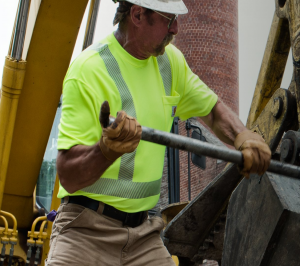HVAC Technician Uniforms and What’s Trending
Let’s be honest here. For most of the last 20-30 years, HVAC technician uniforms—along with the attire of other branches across numerous field service industries—have looked something like this:

Now, while Jason here—we’re not exactly sure if that’s his real name, but he looks like a “Jason” to us—could perhaps be wearing more specific clothing like a shirt with a name-brand logo across his chest, the key point is this: nobody is confusing Jason with:

HVAC service technician uniforms have never been fashionable or trendy, and would certainly not be “Blue-Steel-approved.” The hard hats, the steel-toed boots, and the generic t-shirts worn by field service technicians are meant to be suited to the tasks at hand. The goal is function, not fashion. However, we have noticed that certain companies are improving upon the fashionable aspects of the traditional HVAC technician uniforms, and it has us wondering: could HVAC service technician uniforms be evolving into a new market sector for fashion retailers?
It might be. For example, back in the summer of 2013, Wrangler released a new “construction pant.” Along with Wrangler’s new pants, Carhartt created a “high-visibility, zip-front, Class 3, thermal-lined sweatshirt” for HVAC and other field service industry technicians—and it’s only about $90. There’s also this piece of apparel from Scotchlite:
 Talk about pops of color! Sturdy pants! This is a man with all the answers.
Talk about pops of color! Sturdy pants! This is a man with all the answers.
All joking aside, the HVAC service technician uniform and apparel sector of the field service industry is big business. As another example, Gartner has predicted that wearable technology such as mounted headsets or Google Glass eyewear could save the field service industry $1 billion by 2017—and surely even more by 2018. The real-time, on-site data gathered by some of these devices like this wrist-mounted computer —
 — can be shared across different departments in your field service organization for more effective marketing and forecasting. Ultimately, the goal to utilizing wearable technology as part of your business’s HVAC technician uniforms is to achieve an increased first-time fix rate, better reviews, and increased revenue generation. And we all know this stitch of wisdom to be true: it doesn’t hurt to look good while you’re doing all of these tasks.
— can be shared across different departments in your field service organization for more effective marketing and forecasting. Ultimately, the goal to utilizing wearable technology as part of your business’s HVAC technician uniforms is to achieve an increased first-time fix rate, better reviews, and increased revenue generation. And we all know this stitch of wisdom to be true: it doesn’t hurt to look good while you’re doing all of these tasks.
The rise of wearable technology in the workplace, and incorporating these wearables into your HVAC technician uniforms is inevitable and logical. HVAC and other field service technicians spend all day at jobsites with customers, and are oftentimes in conditions that make it critical to have the right type of clothing in order to complete a job safely and in a timely manner. When Wrangler released the construction pant that is displayed in the link above, the company noted that, “A workman’s clothing is one of the most important tools he depends on during demanding hours on the job.” This statement is indeed quite true.
In today’s working environment, one of the trendiest “accessories” that pairs well with HVAC service technician uniforms is of course:
 No, that’s not a “murse” (man-purse.) It’s an iPad/Surface/tablet. For decades, field service technicians didn’t carry or utilize a lot of technology-driven devices. They mainly carried tools, jobsite materials, and inventory items to customer locations.
No, that’s not a “murse” (man-purse.) It’s an iPad/Surface/tablet. For decades, field service technicians didn’t carry or utilize a lot of technology-driven devices. They mainly carried tools, jobsite materials, and inventory items to customer locations.
That’s drastically changed. As field service companies begin to rapidly adopt mobile devices and field service management software—like the product we develop—more integration and connectivity has been realized in HVAC and other field service industry businesses. The principles of interconnectedness even extend to technicians in the field.
Our mobile software has FSM integration with all of your other business practices so that everything is automatically updated as it is happening—both on the desktop version and on technicians’ mobile apps. There’s even offline mobile work tracking that syncs with your desktop versions as soon as the mobile device reconnects.
Although we wouldn’t necessarily recommend a loose-fitting t-shirt in the field at most jobsites, we would encourage you to sport this number:
 What are the implications of making this your companies go-to HVAC technician uniform? There are two things that can happen when you wear that shirt:
What are the implications of making this your companies go-to HVAC technician uniform? There are two things that can happen when you wear that shirt:
The customer laughs, and a customer relationship begins to be established.
The customer is not pleased—meaning you really shouldn’t have worn that shirt.
Simply because we worry that your customers would react in the way option (2) describes, we recommend not making that t-shirt part of your HVAC service technicians’ uniforms. However, while we’re on the topic of clothes you probably should not wear to a customer jobsite, here’s one more look for your viewing pleasure:
 Finally, here is one last fun fact for the road: If you do a Google Images search for “service technician attire,” one of your top image hits is this:
Finally, here is one last fun fact for the road: If you do a Google Images search for “service technician attire,” one of your top image hits is this:
 Admittedly, we don’t know Victoria Beckham’s (Posh Spice) full résumé, but we would bet that she never worked as a field service tech.
Admittedly, we don’t know Victoria Beckham’s (Posh Spice) full résumé, but we would bet that she never worked as a field service tech.
That connection to the world of high fashion aside, field service clothing—including HVAC service technician uniforms—is likely to remain more functional than fabulous for several generations. It’s much more about getting the work done in an efficient manner than the client commenting on the pops of color on your techs’ t-shirts, and the trendy flare on their work pants. Accessorizing HVAC technician uniforms is more likely to be tablet and mobile based than hard hat and tool belt driven in the coming years. (Although, in reality, your hard hat and tool belt won’t be going anywhere.)
This shift to field techs being constantly surrounded by—and utilizing new—technology is one of a host of changes taking place in field service industries today. To understand more about the workplace and jobsite environment of these industries—and consider how to embrace the change management practices that get your team aligned and comfortable with changing technology toward—download our eBook about getting ready for 2018 now.


